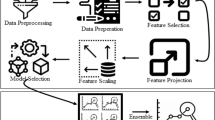Abstract
In this paper, we classify the breast cancer of medical diagnostic data. Information gain has been adapted for feature selections. Neural fuzzy (NF), k-nearest neighbor (KNN), quadratic classifier (QC), each single model scheme as well as their associated, ensemble ones have been developed for classifications. In addition, a combined ensemble model with these three schemes has been constructed for further validations. The experimental results indicate that the ensemble learning performs better than individual single ones. Moreover, the combined ensemble model illustrates the highest accuracy of classifications for the breast cancer among all models.





Similar content being viewed by others
References
Thomas, G. D., Ensemble methods in machine learning. In Proc. of the First International Workshop on Multiple Classifier System (MCS 2000), 1–15, 2000.
Tsymbal, A., Pechenizkiy, M., and Cunningham, P., Diversity in search strategies for ensemble feature selection. Inform. Fusion 6:83–98, 2005.
Xing, E. P., et al., Feature selection for high-dimensional genomic microarray data. In ICML’01: Proceedings of the Eighteenth International Conference on Machine Learning, 601–608. Morgan Kaufmann Publishers Inc., San Francisco, CA, USA, 2001.
Mitchell, T., Machine learning. McGraw-Hill, New York, 1997.
Yao, X., and Liu, Y., A new evolutionary system for evolving artificial neural networks. IEEE Trans. Neural Netw. 8:694–713, 1997.
Wang, Z., “Neuro-Fuzzy ensemble approach for microarray cancer gene expression data analysis,” 2006 International Symposium on Evolving Fuzzy Systems, September, 2006.
Ding, C. H. Q., and Peng, H., Minimum redundancy feature selection from microarray gene expression data. In CSB, 523–529, 2003.
UC Irvine Machine Learning Repository http://archive.ics.uci.edu/ml/datasets/Breast+Cancer+Wisconsin+%28Original%29
Mangasarian, O. L., and Wolberg, W. H., Cancer diagnosis via linear programming. SIAM News 23(5):1–18, 1990.
Quinlan, J. R., Improved use of continuous attributes in C4.5. J. Artif. Intell. Res. 4:7–90, 1996.
Sharkey, A. J. C., Sharkey, N. E., et al., Adapting an ensemble approach for the diagnosis of breast cancer. Proceedings of ICANN, 1998.
Abonyi, J., and Szeifert, F., Supervised fuzzy clustering for the identification of fuzzy classifiers. Pattern Recogn. Lett. 24:2195–2207, 2003.
Martínez-Muñoz, G., and Suárez, A., Switching class labels to generate classification ensembles. Pattern Recogn. 38:1483–1494, 2005.
Şahan, S., Polat, K., Kodaz, H., et al., A new hybrid method based on fuzzy-artificial immune system and k-nn algorithm for breast cancer diagnosis. Comput. Biol. Med. 37(3):415–423, 2007.
Author information
Authors and Affiliations
Corresponding author
Rights and permissions
About this article
Cite this article
Hsieh, SL., Hsieh, SH., Cheng, PH. et al. Design Ensemble Machine Learning Model for Breast Cancer Diagnosis. J Med Syst 36, 2841–2847 (2012). https://doi.org/10.1007/s10916-011-9762-6
Received:
Accepted:
Published:
Issue Date:
DOI: https://doi.org/10.1007/s10916-011-9762-6




